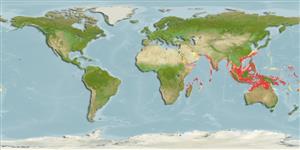Common names from other countries
Environment: milieu / climate zone / depth range / distribution range
पारिस्थितिकी
समुद्री प्रवाल-भित्ति संयुक्त; गहराई सीमा 20 - 200 m (Ref. 11441). Tropical; 30°N - 19°S
Indo-West Pacific: Persian Gulf to the western coast of India, eastward to the Pacific, where it occurs from Taiwan southward to the Arafura Sea (Ref. 9819) and northern Queensland, Australia (Ref. 3414).
Length at first maturity / आकार / वज़न / Age
Maturity: Lm 21.1 range ? - ? cm
Max length : 35.0 cm TL पुल्लिंग / अलिंग; (Ref. 11441); common length : 25.0 cm TL पुल्लिंग / अलिंग; (Ref. 3483)
Inhabits coral or rocky areas. Sometimes forms aggregations. Feeds on a wide variety of benthic animals. Smaller fish are mostly found inshore. Marketed mostly fresh, whole or dried-salted.
Starnes, W.C., 1988. Revision, phylogeny and biogeographic comments on the circumtropical marine percoid fish family Priacanthidae. Bull. Mar. Sci. 43(2):117-203. (Ref. 5403)
IUCN Red List Status (Ref. 130435)
CITES (Ref. 128078)
Not Evaluated
Threat to humans
Harmless
Human uses
मात्स्यिकी: लघु वाणिज्य
अधिक जानकारी
संदर्भजलीयकृषिजलीयकृषि रूपरेखाखींचआनुवंशिकीElectrophoresesहैरेटिबिलटीबीमारीप्रक्रमणMass conversion
सहयोगीयोतस्वीरेStamps, Coins Misc.ध्वनिसिगुयटिरारफ्तारतैरने के प्रकारगिल क्षेत्रOtolithsदिमागदृष्टि
साधन
Special reports
Download XML
इंटरनेट स्रोत
Estimates based on models
Preferred temperature (Ref.
115969): 21.9 - 28.3, mean 26.8 (based on 847 cells).
Phylogenetic diversity index (Ref.
82804): PD
50 = 0.5002 [Uniqueness, from 0.5 = low to 2.0 = high].
Bayesian length-weight: a=0.02138 (0.01571 - 0.02910), b=2.90 (2.82 - 2.98), in cm Total Length, based on LWR estimates for this species (Ref.
93245).
Trophic level (Ref.
69278): 3.8 ±0.3 se; based on diet studies.
लौटाव (Ref.
120179): ऊंचा, न्यूनतम जनसंख्या दुगनी समय अवलागत 15 महीने। (K=0.6-1.23).
Fishing Vulnerability (Ref.
59153): Low vulnerability (23 of 100).
